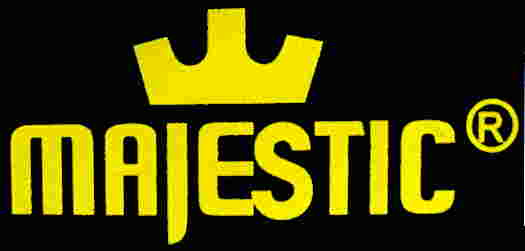
 |
FM keyboard with interesting sound glitches & realtime programmable rhythm |
This fullsize FM keyboard has very plain 2 operator FM sound with realtime programmable rhythm, which in a limited way can be also abused as a tekkno drum computer. There are also interesting sound glitches on this instrument.
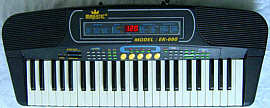 |
 |
Confusing is that the OBS buttons of preset sounds and rhythms are labelled only with numbers instead of sound and rhythm names, and their names instead are written far away on the case top in the manner of a sound bank keyboard and are very badly readable (in blue on dark grey, crossed out by a light grey background line raster). Apparently the designer of this tablehooter attempted to camouflage the OBS controls of this instrument to give it the visual appearance of its technically more advanced sound bank competitors. Thus unlike real sound bank instruments, the LED display also does not indicate the currently selected preset sound or rhythm. Generally the control panel is a little awkward to use by its too small and poorly responding plastic buttons. Initially the volume of my specimen yelled ear tormenting loud, thus reasonably low volume was only adjustable within the first 2mm of the volume slider. Also the amp makes a lot of static noise.
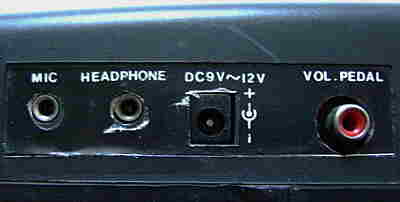 |
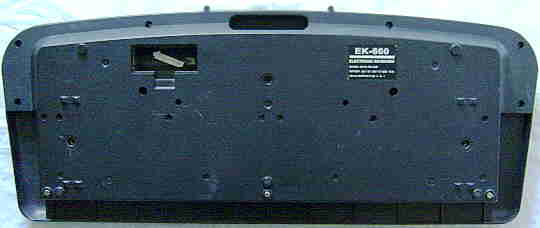 |
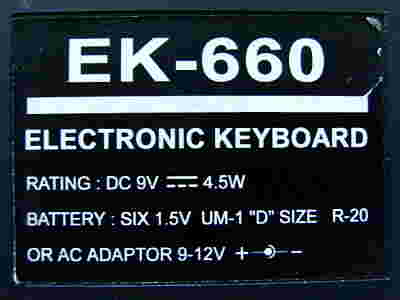 |
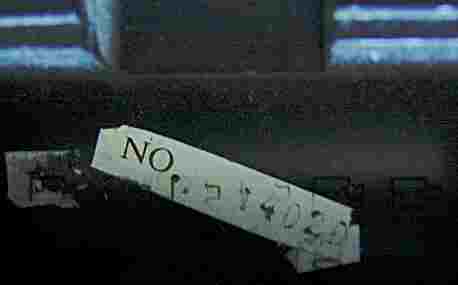 |
 |
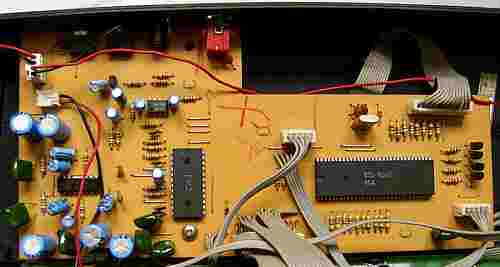 |
 |
The preset sounds of this instrument have the typical 2 operator FM timbres and most are not programmed really realistic but resemble more classic home organ or e-piano timbres since most have simple envelopes and many have nothing to do with their names. Great is also that (like most FM keyboards) the timbres are time- dynamically playable, i.e. the timbre of notes changes depends on how long a key is pressed, which provides a relatively expressive playability despite the keyboard is not velocity sensitive. When a key is trilled, each new note here occupies a new sound channel, which produces a great phasing sound and volume increase effect although this eats up polyphony. The "flute" is a little dull (more a wooden pipe organ rank). The "piano" is the usual infamous FM piano with hollow bass range. The "jazz organ" is a dull Hammond organ timbre with 4hz tremolo. "brass" is a synth trombone timbre while "string" is a slightly glassy but nice violin timbre. The "jazz guitar" sounds like "jazz organ" with a decaying guitar envelope. The "oboe" a little harsh but ok. The "bassoon" is more sonorous and 1 octave lower. The "banjo" is percussive and a little harsh. The "vibes" is a vibraphone sound with 4hz tremolo. The "slapsynth" is a bright distorted e-guitar sound that fades brighter and then dull; with enabled sustain it sounds like a sitar. The "e.piano" is a Rhodes timbre with hollow bass range (more a harp?) and 4hz tremolo. The "pipe organ" is rather a dull electronic organ timbre without clicking attack phase and nicely warm bass range. The "trombone" is a dull synth brass that fades duller. The "cello" reminds a bit to a fat saxophone timbre. The "e. guitar" is more a nylon guitar imitation with typical hollow FM bass range. The "clarinet" sounds ok (has a hollow bass range) and slowly fades silent. The "percuss" is rather a funky e-bass. The "saxphone" is not at all a saxophone but resembles rather a flute with hollow bass range (a bit like tubular bells?) that fades duller. The "koto" is another picked string with nylon guitar timbre. The "vib" button adds vibrato (depth and speed depends on preset sound); unlike other such keyboards this button does not affect held notes. The "sus" button adds sustain to the sounds, during which the tremolo continues (very strong with "percuss"). Like with Letron MC-3, the OBS preset sound buttons can be also used as a realtime sound control, since they also change the timbre of held notes and re- trigger their envelope. Also the "transpose" +/- buttons re-trigger the envelope, although like "tempo" they respond a little slow. Due to its separate FM sound chip, also this instrument can be likely easily modified into a simple FM synthesizer, like I did with the Fujitone 6A (and thanks to the programmable rhythm it may be even more interesting to change the percussion this way) although this instrument does already plenty of glitch sounds by its own.
The metronome has to be enabled with a separate "on/ off" button before it can be started with its own "start/ stop" button. Enabling it automatically disables rhythm and the whole accompaniment section (neither manual bass nor chord and not even the drumpads work here). The metronome plays a normal triangle sound on the first and a muffled (short) triangle on the remaining beats of the bar. (It sounds more like clanging on a ceramic mug with a spoon.) The pattern length can be set between 1 and 10 beats per bar. A bizarre glitch is that the main voice timbre changes alternatingly every 2nd note when the running metronome was switched off by its "on/off" switch without prior stopping it by its "start/stop" button. The exact sound change also depends on whether the long or the short triangle noise of the metronome was playing while it was switched off. Possibly the algorithm that switches between short and long triangle noises somehow stays active here and modifies the envelope. Particularly the "flute" makes a strange fast "meow" during its attack, and resonant sounds (like "slapsynth" or "banjo") even turn into distorted white noise every 2nd note. This can be greatly used as sound effect; particularly with enabled sustain it makes nicely time- dynamically playable timbre changes. The main voice sound turns normal again as soon a new preset sound is selected or by playing any percussion. (But manual bass or chord can be combined with the glitch sound without problems and sound as usual.)
The percussion has the typical electronic FM timbre known from the OPL3 "MIDI synth" of early PC soundcards. Nice is that this instrument has a realtime programmable drum pattern ("custom drummer"), which functions much like with Elta KE-6. Fist you have to select one of the preset rhythms as a template and press the "prog" button, which starts the LED dot chain as walking light in the tempo of the rhythm. Then (similar like a Yamaha PortaSound's "custom drummer") you can now add percussion in realtime with the drumpads to the selected rhythm. You can also clear the entire user pattern (which initially contains the template rhythm) by pressing "clear". During programming mode this automatically plays a hihat as metronome to each bar of the pattern, which later will not appear in the programmed rhythm, which can be quite confusing. You can finish the pattern by pressing "stop" or "play"; the latter seamlessly continues the new rhythm in normal play mode. Unfortunately you can not exchange the accompaniment later without manually re-entering the pattern. If you want to modify the user pattern later, simply press "prog" again while the pattern is running (when off, it is replaced by the current preset rhythm). The programming mode can be also abused as a realtime tekkno drum computer, and unlike Elta KE-6 you can even play keyboard it in this mode, although by unknown reasons the highest note key doesn't work here. The pattern resolution seems to be 32 steps (24 with waltz); with the MC-3 and other similar instruments the user pattern is 16 steps long. The rhythm and metronome tempo can be set only in coarse steps despite the LED display indicates the exact BPM value.
The drumpads need to be enabled with the "percu" button before use, which was likely done to save polyphony. (My Fujitone 6A automatically enables them by first use, but has a similar button to disable them again.) Annoying is that the drumpads respond only with a noticeable delay (about 0.2s?), and they also often get stuck in their wacky plastic frame.
The accompaniment patterns are nicely arranged and have each an intro, fill-in and ending. Some of them sound quite unusual and remind to the cheesy Sankai accompaniments (see e.g. Sankai 01504H). E.g. the "samba" pattern has an untypical banjo arpeggio and many make nice disco or synth pop styles. Fortunately these accompaniments are way less stubborn than Sankai stuff since in fingered chord mode they accept also disharmonic key combinations and not only those few considered "chords" by the establishment; when fewer than 3 keys are pressed, the patterns turn simpler and thus sound less cheesy and over- orchestrated which makes them more useful. During fill-ins the accompaniment is muted. There is also a monophonic manual bass mode, and with rhythm off the usual manual chord mode. Their preset sound depend on the currently selected rhythm. Unusual is that the sustain button also affects the manual bass and chord sound, which makes particularly nice fat and funky FM bass timbres. Bizarre is also that the manual bass timbre and envelops of held notes changes in bizarre ways when OBS preset rhythm buttons are pressed while the manual bass note is sounding. This can result in odd glitch envelopes, white noise timbres and all kind of other weird bubbling FM synth sounds, those can be also used as a realtime sound effect. Likely the CPU writes new FM synthesis parameters into sound chip registers whiles the sound is still playing, which makes the strange noises. Otherwise when a new preset sound is selected, this always stops the manual bass (or chord) note; possibly the programmer confused here something. But the next manual bass note always plays the normal way again, using the timbre corresponding to the selected preset rhythm. (With manual chord notes pressed rhythm buttons only affect later notes and thus cause no strange timbres.)
The Majestic EK-660 responds easily on shitshot with the power switch and makes a lot of nonsense by this. E.g. when rhythm "start/ stop" is held during power-on, it changes (and distorts?) all percussion sounds and also the main voice sounds. They can be returned to normal state by switching the instrument off for a few seconds. Also other buttons make a lot of bizarre sound mess when held during power-on.
Possibly a variant of this instrument might be the Superb Sound EK-380
(rectangular case with 49 fullsize keys and speakers next to them, 20 OBS
preset sounds (some similar names) and 12 rhythms, drums on rightmost keys
instead of drumpads, FM synth sliders (like Yamaha
PSS-390 or even closer the Yamaha PSS-470), simple sequencer,
1 demo melody | seen on eBay). A predecessor may have been the Elta
KE-10. One of the successors may be the midsize Superb
Sound EK-905, which also contains tons of bizarre FM glitch sounds
(although with less complex behaviour).
| removal of these screws voids warranty... | ||
 |
||
|
|